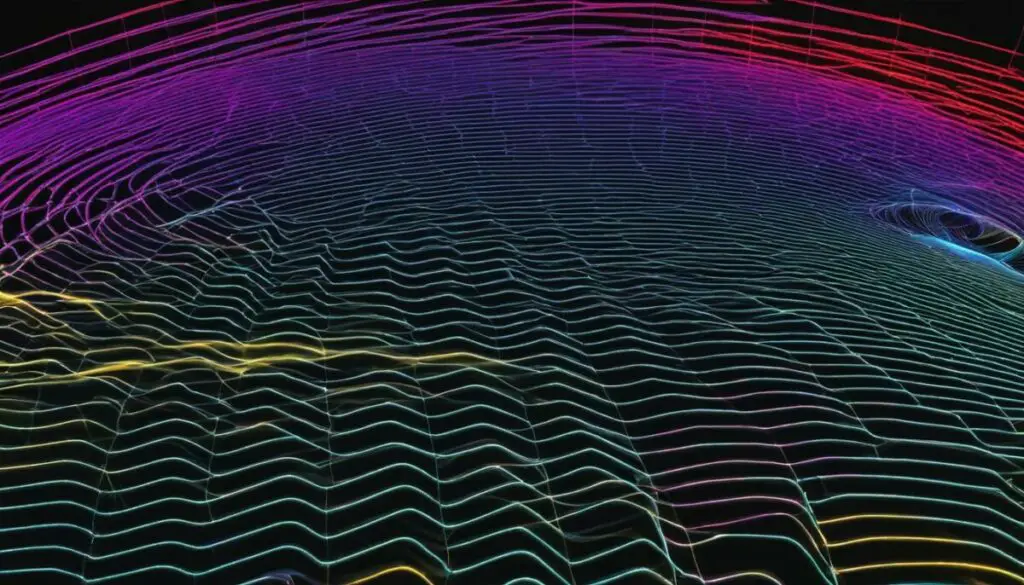Last Updated on 4 months by Francis
Radio waves and infrared radiation are two fascinating components of the electromagnetic spectrum. While both play crucial roles in various fields, they differ in terms of wavelength, frequency, and energy levels.
Radio waves, the focus of this article, are a form of electromagnetic radiation widely used for communication. They have considerably longer wavelengths than visible light, ranging from a few millimeters to hundreds of kilometers. In contrast, infrared radiation has slightly higher energy and shorter wavelengths than radio waves. Together, they occupy different parts of the electromagnetic spectrum, each with its unique characteristics.
Contents
Key Takeaways:
- Radio waves and infrared are different regions of the electromagnetic spectrum.
- Radio waves have longer wavelengths than visible light.
- Infrared radiation has shorter wavelengths and higher energy.
- Radio waves are essential for communication and wireless transmission.
- Understanding the electromagnetic spectrum enhances our knowledge of its applications across various fields.
The Characteristics of Radio Waves

Radio waves are a fundamental component of modern communication systems, providing the means for transmitting and receiving information over long distances. Understanding the characteristics of radio waves is essential to grasp how they enable wireless communication.
One notable characteristic of radio waves is their wavelengths. Compared to visible light, radio waves have much longer wavelengths, ranging from a few millimeters to hundreds of kilometers. This extended wavelength allows radio waves to travel through various obstacles, such as buildings or foliage, making them ideal for long-range communication.
Another critical aspect of radio waves is their frequency. Radio waves oscillate at frequencies between a few kilohertz and a few terahertz. Frequency determines the number of complete wave cycles per second, and it plays a crucial role in signal transmission and reception.
Radio waves have numerous applications in modern society, including television and radio broadcasts, military communications, mobile phones, and wireless computer networks. These applications utilize the different wavelengths and frequencies of radio waves to enable reliable and efficient communication.
Most radio waves easily pass through Earth’s atmosphere, facilitating widespread transmission. However, certain frequencies can be affected by the ionosphere, a region of charged particles in the upper atmosphere. This interaction can lead to reflection or absorption of radio waves, influencing the effectiveness of transmission and reception.
The Impact of the Ionosphere
The ionosphere, a region of Earth’s atmosphere, plays a significant role in radio wave propagation. It can reflect or absorb specific frequencies, affecting their ability to travel long distances. This phenomenon is particularly important in long-distance communication, such as international radio broadcasts or military transmissions.
To visualize the characteristics of radio waves, let’s take a closer look at their wavelengths and frequencies in a table:
| Frequency Range | Wavelength Range |
|---|---|
| Very Low Frequency (VLF) | 10,000 – 100,000 meters |
| Low Frequency (LF) | 1,000 – 10,000 meters |
| Medium Frequency (MF) | 100 – 1,000 meters |
| High Frequency (HF) | 10 – 100 meters |
| Very High Frequency (VHF) | 1 – 10 meters |
This table demonstrates how different frequency ranges correspond to varying wavelength ranges. As the frequency increases, the wavelength decreases, allowing for different applications of radio waves in different frequency bands.
Overall, the unique characteristics of radio waves, with their diverse wavelengths and frequencies, enable seamless transmission and reception of information across vast distances, making them an integral part of our communication systems.
Microwaves: A Type of Radio Wave

Microwaves are a type of radio wave that falls within the electromagnetic spectrum. They have wavelengths ranging from a few millimeters to tens of centimeters, making them shorter than traditional radio waves. Microwaves are commonly known for their use in cooking, but they also play a crucial role in communication technology and wireless communication.
One of the key applications of microwaves is in wireless communication. They are used in various devices such as cell phones, Wi-Fi networks, and satellite communications. Microwaves allow for the transmission of data, voice, and video signals over long distances without the need for physical cables.
Microwave technology forms the backbone of modern communication systems, enabling seamless wireless connectivity and enabling people to stay connected wherever they are. It has revolutionized the way we communicate, making it faster, more convenient, and accessible to millions of people around the world.
The Role of Radio Waves in Wireless Transmission

Radio waves play a crucial role in the wireless transmission of sound messages and information, making communication technology possible. They are utilized in various applications, including maritime and aircraft navigation, where they enable effective communication between ships, planes, and control towers.
When it comes to wireless transmission, radio waves are modulated to carry different types of signals, such as amplitude modulation (AM), frequency modulation (FM), or digital signals. This modulation allows for the encoding and decoding of information, enabling clear and reliable communication between devices.
The frequency band of radio waves used for transmission depends on the information density and the specific requirements of the communication system. For example, telephone signals typically use a frequency band of around 10,000 Hz, while high-definition television signals require a larger bandwidth of several megahertz.
The width of the frequency band determines the amount of data that can be transmitted within a given time frame. A wider band allows for higher data rates and more efficient transmission, while a narrower band limits the amount of information that can be sent simultaneously.
The Ionosphere and the Ground Wave in Long-Distance Transmission
Long-distance radio transmission relies on two important factors: the ionosphere and the ground wave.
The ionosphere is a region in Earth’s atmosphere that is partially ionized by the Sun’s ultraviolet light. This ionization allows radio waves to be reflected or bent, making long-distance transmission possible.
The ionosphere can bounce radio waves back to the Earth’s surface, allowing them to travel over large distances. This phenomenon is particularly useful for long-range communication, as the waves can reach areas beyond the line of sight.
In addition to the ionosphere, the ground wave also contributes to long-distance transmission. The ground wave closely follows the contour of the Earth’s surface, allowing radio waves to propagate over extended distances, especially in urban areas.
By leveraging the properties of the ionosphere and the ground wave, wireless communication systems can achieve reliable and efficient transmission, enabling people from different locations to connect and communicate seamlessly.
Unlocking the Potential of Communication Technology
The use of radio waves in wireless transmission has revolutionized communication technology. It has enabled advancements in various fields, including telecommunications, broadcasting, and mobile devices.
Telecommunication networks rely on radio waves to carry voice and data signals over long distances, making it possible for people to communicate with one another across vast distances. From traditional telephone networks to modern cellular networks, radio waves are the backbone of these systems.
Broadcasting systems, such as radio and television, utilize radio waves to transmit entertainment, news, and educational content to a wide audience. Radio waves allow these signals to be distributed over large geographic areas, reaching millions of listeners and viewers.
Mobile devices, including smartphones and wireless routers, utilize radio waves in the form of Wi-Fi and cellular connections. These devices rely on radio wave transmission to connect to the internet, enabling people to access information and communicate wirelessly.
In conclusion, radio waves play a vital role in wireless transmission, forming the foundation of modern communication technology. Understanding their properties and utilizing them effectively allows for seamless and efficient communication across vast distances.
The Relationship Between Radio Waves and Infrared
Radio waves and infrared are both part of the electromagnetic spectrum, occupying different regions with distinct characteristics.
Radio waves have long wavelengths and low frequencies. They are used for various purposes in communication, navigation, and wireless transmission. With their ability to pass through objects and travel long distances, radio waves have revolutionized the way we connect and communicate.
Infrared radiation, on the other hand, has shorter wavelengths and higher energy. It is invisible to the human eye but can be detected as heat. Infrared light records the heat signature of objects or environments, making it useful in applications such as thermal imaging and night vision technology.
While radio waves and infrared are different in terms of wavelength and energy, they both contribute to various fields, showing the versatility and significance of the electromagnetic spectrum.
Radio Waves and Their Propagation

Radio waves, a type of electromagnetic radiation, have the remarkable ability to travel long distances for communication purposes. This is due to the fascinating phenomena of reflection and bending, which are facilitated by elements in Earth’s atmosphere.
One of the key players in the propagation of radio waves is the ionosphere. The ionosphere is a region in Earth’s atmosphere that becomes partially ionized by the Sun’s ultraviolet light. As a result, it can reflect or bend radio waves, enabling long-distance transmission. This process is particularly useful for communication over vast areas, such as international broadcasts or long-range military communications.
The ground wave, on the other hand, contributes to the transmission of radio waves by following Earth’s surface closely. It allows for effective communication over shorter distances, such as local radio stations or wireless networks within a limited range.
The behavior and range of radio waves depend on their frequencies and their interaction with the ionosphere. Different frequencies are affected differently by the ionosphere, resulting in varied transmission patterns. For example, lower frequency radio waves tend to penetrate the ionosphere and propagate further, while higher frequency waves may be absorbed or reflected back to Earth.
In summary, the ionosphere and the ground wave are crucial factors in the propagation of radio waves. They enable the extraordinary ability of radio waves to travel over long distances, making them an essential tool in various communication technologies.
| Factors | Impacts |
|---|---|
| Frequency | Determines the behavior of radio waves in the ionosphere and their range of propagation. |
| Ionosphere | Allows for reflection and bending of radio waves, enabling long-distance transmission. |
| Ground Wave | Contributes to transmission over shorter distances by closely following Earth’s surface. |
Applications of Radio Waves

Radio waves have a wide range of applications in various fields, playing a crucial role in communication, radar systems, and wireless transmission. Their unique properties make them indispensable for numerous technological advancements and innovations.
1. Communication
One of the primary uses of radio waves is in communication systems. They are utilized for radio and television broadcasting, enabling the transmission of news, entertainment, and educational content to a broad audience. Radio waves also facilitate military communications, ensuring secure and reliable information exchange between armies and defense organizations.
Moreover, radio waves form the foundation of modern wireless communication technologies. They enable the operation of GPS devices, which provide precise positioning and navigation services. Wireless computer networks, such as Wi-Fi, rely on radio waves to establish seamless connections between devices, allowing the transfer of data without the need for physical cables.
2. Radar Systems
Radar, which stands for “Radio Detection and Ranging,” employs radio waves for various applications. Radar systems use radio waves to detect and track objects in their vicinity. This technology finds extensive use in aviation for aircraft navigation and collision avoidance. It is also integral to maritime navigation, enabling ships to determine their position and avoid hazards.
Furthermore, radar imaging systems utilize radio waves to create detailed images of distant objects or environments. These images provide valuable information for weather monitoring, terrain mapping, and even studying celestial bodies.
3. Wireless Transmission
Wireless transmission relies heavily on radio waves to transmit information over long distances. The ability of radio waves to penetrate nonconducting materials makes them ideal for wireless communication through walls and obstacles. This property is utilized in technologies such as Bluetooth, which enables wireless connections between devices such as headphones, speakers, and smartphones.
Additionally, wireless transmission plays a vital role in the field of telecommunications, where radio waves are modulated to carry voice and data signals. This allows for wireless telephony and mobile communication networks. The advent of 5G technology has further expanded the capabilities of wireless transmission, enabling faster and more reliable communication.
Transmission of Electromagnetic Energy

The transmission of electromagnetic energy, including radio waves, can be achieved through guided or wireless means. Guided transmission involves the use of wires, coaxial cables, and waveguides to confine the waves to a limited region. This method is commonly used for cable television, where high-quality signals are provided to users.
Wireless transmission, on the other hand, is preferred in situations where the locations of receivers are unspecified or numerous. It enables the seamless transmission of radio and television communications.
One example of wireless transmission is the broadcasting of radio waves. Radio stations transmit signals through the air to be picked up by radios, allowing listeners to tune in to their favorite programs. Television networks also utilize wireless transmission to broadcast television signals, enabling viewers to enjoy their favorite shows without the need for physical connections.
Let’s take a closer look at how cable television uses a guided transmission system for high-quality signal delivery:
| Transmission Type | Advantages | Disadvantages |
|---|---|---|
| Guided Transmission |
|
|
| Wireless Transmission |
|
|
As seen in the table above, each transmission type has its own set of advantages and disadvantages. Guided transmission offers high-quality signals and is less susceptible to interference, but it requires physical connections and incurs costs for installation and maintenance. On the other hand, wireless transmission allows for flexible and convenient connections, but it can be affected by interference and has range limitations.
In conclusion, the transmission of electromagnetic energy, including radio waves, can be achieved through guided or wireless means. Each method has its own benefits and drawbacks, making them suitable for different scenarios and applications.
Radio Waves in Research and Medicine
Radio waves play a vital role in both research and medicine, contributing to significant advancements in various fields. One prominent application is found in magnetic resonance imaging (MRI), a widely used diagnostic technique.
MRI utilizes a combination of strong magnetic fields and radio waves to create detailed images of the human body without apparent harmful effects. The radio waves are directed at the body, causing the hydrogen atoms within the tissues to emit signals. These signals are then detected by the MRI machine, which translates them into visual representations. This non-invasive imaging technique provides valuable insights into the structure and functioning of organs, aiding in the diagnosis of various medical conditions.
In addition to its role in medical diagnostics, radio waves are also prevalent in the field of radio astronomy. Ground-based telescopes utilize radio waves to observe and study celestial objects and phenomena in deep space. By analyzing the radio waves emitted by distant galaxies and other cosmic entities, astronomers can gather valuable data and gain a better understanding of the universe.
Overall, radio waves have proven to be invaluable tools in both research and medicine. From the diagnostic capabilities of MRI to the exploration of the cosmos through radio astronomy, their applications continue to push the boundaries of scientific understanding and improve human health.
Conclusion
Radio waves and infrared are crucial components of the electromagnetic spectrum, each with its own unique characteristics. Radio waves, known for their long wavelengths, are widely used in communication technology, enabling us to transmit and receive information across various devices and platforms. In contrast, infrared radiation, although invisible to the human eye, plays a significant role in recording heat signatures and is harnessed in applications such as thermal imaging and medical diagnostics.
Understanding the relationship between radio waves and infrared expands our knowledge of the electromagnetic spectrum and its diverse range of applications. From wireless communication and radar systems to medical imaging such as Magnetic Resonance Imaging (MRI), the utilization of both radio waves and infrared enables advancements in technology and enhances our ability to explore and understand the world around us.
As we delve deeper into the electromagnetic spectrum, we unlock new possibilities for innovation, ensuring that radio waves and infrared continue to shape and transform various industries. By harnessing the power of these electromagnetic phenomena, we can communicate, navigate, and observe the universe in ways that were once unimaginable.
FAQ
Are radio waves and infrared the same thing?
No, radio waves and infrared are not the same thing. While both belong to the electromagnetic spectrum, they occupy different regions with distinct characteristics. Radio waves have longer wavelengths and lower frequencies, while infrared radiation has shorter wavelengths and higher energy.
What are the characteristics of radio waves?
Radio waves have wavelengths ranging from a few millimeters to hundreds of kilometers and oscillate at frequencies between a few kilohertz and a few terahertz. They are used for various communication applications, including television and radio broadcasts, mobile phones, and wireless computer networks.
What role do radio waves play in wireless transmission?
Radio waves are instrumental in wireless transmission and play a crucial role in communication technologies like cell phones, Wi-Fi networks, and satellite communications. They are modulated to carry amplitude modulation (AM), frequency modulation (FM), or digital signals.
How do radio waves relate to infrared?
Radio waves and infrared are both part of the electromagnetic spectrum, but they occupy different regions with distinct characteristics. Radio waves have longer wavelengths and lower frequencies, while infrared radiation is invisible to the human eye and records heat signatures.
How do radio waves propagate?
Radio waves can be reflected or bent by the ionosphere, a region in Earth’s atmosphere partially ionized by ultraviolet light from the Sun. This phenomenon allows for long-distance transmission by bouncing the waves off the ionosphere. The ground wave, which closely follows Earth’s surface, also contributes to long-distance transmission.
What are the applications of radio waves?
Radio waves find applications in various fields, including communication, radar systems, and wireless transmission. They are used for radio and television broadcasting, military communications, GPS devices, radar imaging, and wireless computer networks.
How is electromagnetic energy transmitted?
Electromagnetic energy, including radio waves, can be transmitted through guided or wireless means. Guided transmission involves wires, cables, and waveguides to confine the waves to a limited region, while wireless transmission, such as radio and TV communications, is preferred for situations where receivers’ locations are unspecified or numerous.
How are radio waves used in research and medicine?
Radio waves play a vital role in research and medicine. Magnetic resonance imaging (MRI) utilizes a combination of radio waves and strong magnetic fields to produce diagnostic images of the human body without apparent harmful effects. Radio waves are also employed in radio astronomy, where ground-based telescopes observe deep space phenomena.
Are there any similarities between radio waves and infrared?
While radio waves and infrared have distinct characteristics, they both form part of the electromagnetic spectrum and contribute to various fields. Both are utilized in communication, navigation, and medical imaging, albeit in different ways.








